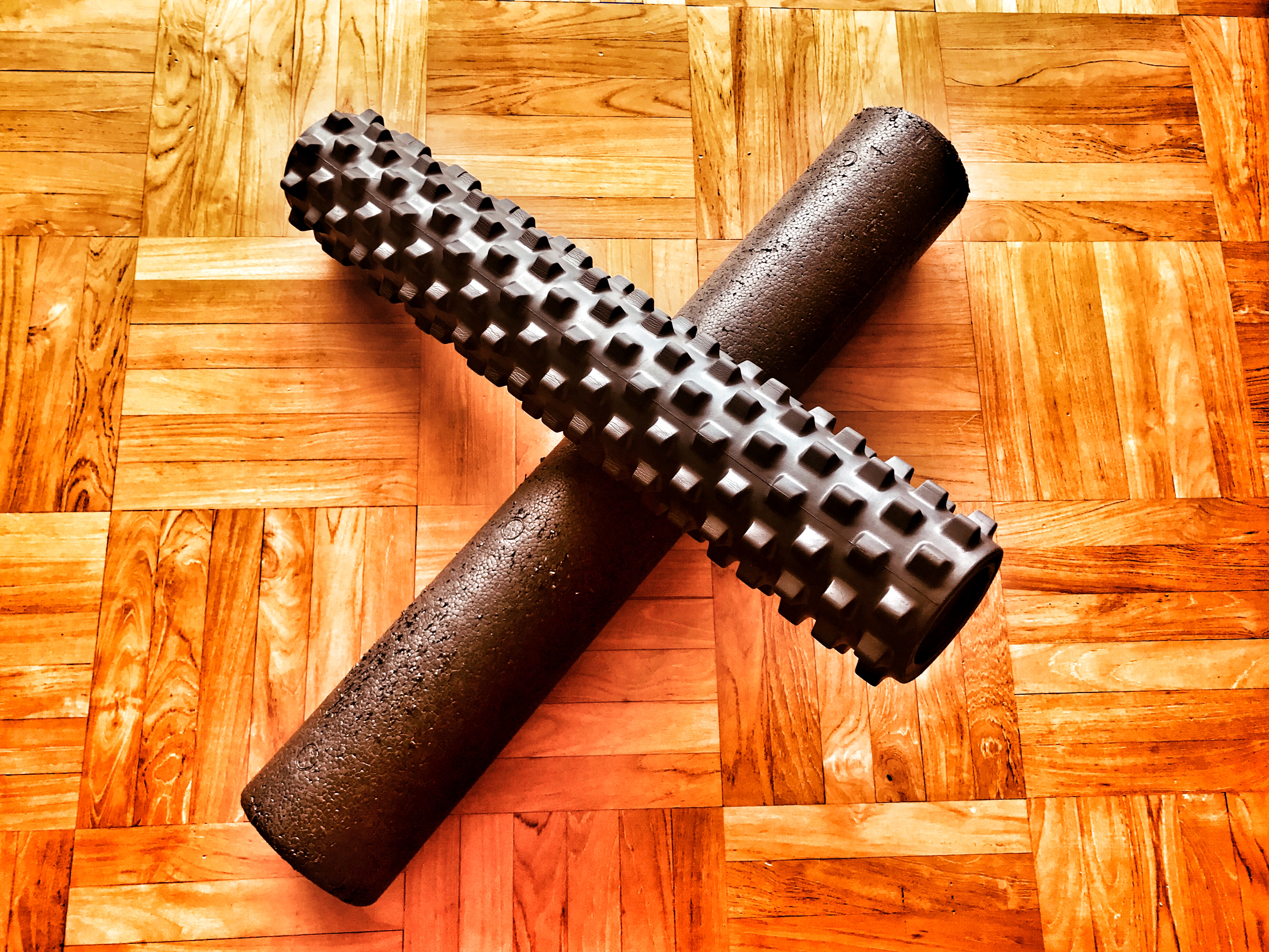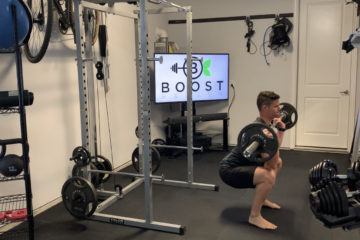
It has been almost exactly one year since I put my foam rollers in the corner of my home gym to collect dust. In March of 2017 I listened to an episode of the Ben Greenfield Fitness Podcast and Jacob Schoen, of SHIFT Sport and Wellness, was a guest. They discussed spinal health, ELDOA methodology, importance of understanding fascia, foam rolling, and more. One of the key takeaways from their discussion for me was that I needed to try ELDOA stretching and also my foam roller may be doing me more harm than good. Jacob mentioned that there is a possibility that aggressive foam rolling could actually be putting too much pressure on the fascia, arteries, veins, and nerves, and also pushing water out the areas being worked. He also mentioned that, while rolling or smashing an injured area may provide some pain relief and improved range of motion, the quality of tissue that is repairing in that area may be poor.
I was intrigued. Had I been doing something that was potentially more harmful than helpful? I had been suffering for a couple of years with a chronic hamstring injury. I injured it on a run and was continuing to have trouble with it, despite a bout of physical therapy. I told the physical therapist I was foam rolling and was told to “keep it up”. Also foam rollers have been a hot item in the fitness industry for many years, touted for their benefits found in studies to decrease soreness, increase range of motion, and improve performance.
As many of you know, I am a protocol junkie, and the evidence seemed to point to smashing and rolling as a “no brainer” for any workout program. As such, I dutifully did smashing and foam rolling on the injured area and everywhere else fairly regularly. I would smash and foam roll pre-workout and post-workout on most days, and fairly aggressively mind you. I never got any better. I would go out for a run and feel that nagging, pulling, twinge feeling almost immediately and throughout the run. I have trained through, and recovered from, a million injuries but this one just wouldn’t let go. When I listened to the aforementioned show with Ben and Jacob I started to wonder if the foam rolling and smashing was harming me. Maybe I was squishing water out and building up yucky scar tissue in the injured area. If so, I wasn’t doing myself any favors and not allowing it to heal properly.
I will share my personal science experiment with you. It is an n=1 experiment so I will admit it isn’t super scientific, but perhaps some of you have been trying to smash an injury into oblivion like I was. Maybe you are wishing for a miracle with the roller but it hasn’t come true, as was I. Maybe you just need to try a different approach and take a break from rolling and smashing, like I did. Maybe leaving the tissue alone to heal is a good idea. On March 21, 2017, I decided to set aside the foam roller. I was nervous that I would fall apart without it though! I had been using it almost daily for years. But my fears subsided quickly because I started to feel better almost right away.
I looked back at my journal and on March 23, 2017, 2 days after I ditched the foam roller, I see I wrote “Did bike/run brick with no foam rolling and was fine. Performance was ok”. It was almost like I was surprised that my leg didn’t fall off! Then later in the year on May 20, 2017, I wrote “Did the Dragons triple triathlon and didn’t notice hamstring at all except a tiny bit when torqueing heavy on bike”. Fast forward to today, I only notice a tiny twinge during a full leg swing, full speed sprint, and heavy torque on the bike. I would say my hamstring is now at about 95%, where last year at this time I was probably more like 70%, when considering pain, range of motion, and power. I go on rides and runs now where I get home and think to myself that I didn’t even notice my hamstring. This is tremendous progress.
My nutrition and exercise program is nearly identical. The only real changes in my programming were getting rid of the rolling, and adding in the ELDOA L5-S1 stretch after my workouts as part of my cool down. I am not an ELDOA expert so I won’t try to speak to the protocols. According to world renowned osteopath Guy Voyer, the general concept with ELDOA is to use specific postures to put your fascia into tension in a specific way which can improve articular blocks and compactions.
I can’t say the improvement in my hamstring was in part due to doing the ELDOA move, but it didn’t seem to hurt. It made sense for me to treat the fascia differently after understanding a bit more about what is happening under the skin, inside the fascia. Maybe we shouldn’t be smashing it to death. Here is a video of the guys at Mind Pump practicing the ELDOA L5-S1 with Stefanie Obregozo.
They did a great job and it really helped me get started with this move. Truth be told I won’t ever get that 95% up to 100% unless I go get professional help to see where my imbalance is. Perhaps it is an issue that can be fixed by getting a hip adjustment and/or focused exercises. Either way it is likely something upstream that caused the injury in the first place and needs to be corrected by a pro. No amount of foam rolling and smashing on my own will fix that.
After having such good success with my n=1 experiment I was inspired to dig a bit into the research to see if I am possibly an anomaly, or if others may benefit from taking a break from the roller. There are certainly benefits to rolling, and everyone responds differently to different stimuli, so I don’t want to be too emphatic on this. With that said, here are my 3 reasons to stop foam rolling:
1. Conflicting Research
There just isn’t enough clear research to show that foam rolling is a must to include in every program. You wouldn’t know that if you look around most exercise facilities, rehab centers, and home gyms though. These things are everywhere! I remember when I was rolling daily, and I had to travel for work, I was surprised and disappointed if a hotel gym didn’t have a roller. They even make small “travel rollers” for those who can’t go without for a few days. This is ridiculous, but I can relate. Let’s look at a few studies to show the disparity. In a 2011 study in the Journal of Strength & Conditioning Research, the results show that 30 seconds of foam rolling on each of the lower-limbs and back had no effect on performance for vertical jump power, vertical jump height, isometric force production, speed, and agility tests.
Strange enough, however, a well-known 2014 study in Medicine and Science in Sports and Exercise found that foam rolling post workout caused a reduction in soreness, and also improved vertical jump height, muscle activation, and range of motion.
That all seems like pretty good stuff right!? But the reasons that the rolling caused these benefits to occur should be considered. The researchers believe that the improvements in soreness, range of motion, and performance from foam rolling were neural in nature. This would lead you to hypothesize that these were temporary adaptations and not actually improvements in muscular power or long term flexibility. It also makes you wonder if not allowing the body to take the normal course through soreness may be a poor choice. Maybe active recovery with walking or swimming, for example, to relieve soreness is a more natural choice when compared to rolling, and possibly the better method for long term health. Interestingly, you can’t even count on foam rolling increasing range of motion in every research study. A 2015 study in the Open Orthopedics Journal found that 2 minutes of foam rolling did not increase hamstring flexibility at the knee joint.
Also a 2016 study in the International Journal of Sports Physiology and Performance found that static stretching alone increases joint range of motion due to decreased muscle stiffness and increased stretch tolerance. But when foam rolling was added in, there were no additional improvements found.
You could argue that you may have had similar results if you did foam rolling alone, which could be true. But I think the take away here is that you can get increased range of motion and flexibility from static stretching alone, without the possible negative effects of smashing and rolling.
2. You Are Not a Massage Therapist
Did you know it matters how fast you massage depending on how deep you are digging in? Did you know if you are doing deep massage that you should only work in the direction of your heart? Did you know you should not do deep tissue work after a workout? I sure didn’t know these things when I was rolling and smashing daily, but according to licensed massage therapist, Rob Gibson, you have to be very careful if massaging or rolling deep into the tissue.
Apparently if you don’t go in the proper direction and proper speed you can rupture valves inside your veins and cause blood pooling and varicose veins. Also deep tissue work post workout can be deleterious because you can further damage already sensitive muscle tissue and veins due to the extra blood in the muscles. It is also important to understand that your muscle fibers run in all different directions throughout your body. A trained therapist will know how to work each area based on their knowledge of the muscle fiber direction, injury if applicable, range of motion, etc. My point is that maybe we should just stick to some static stretching post workout and leave the tissue work to the pros.
3. No Improvement
This one seems like a “no brainer” but heck I did foam rolling for years without any improvement in my hamstring. I guess I thought I would eventually “get it”. Rolling at just the right angle, or at the proper time, or with a certain tool. At some point you have to realize that there isn’t going to be a miracle where you smash it just right and are magically healed. Keep a simple journal of how you feel pre and post workout. If you don’t feel improvement relatively soon then consider alternative methods. One easy test could be to use the roller for one week, then go one week without, and note any variation. Most importantly, see a medical professional to help you with an injury before it becomes too chronic. Don’t wait for magic from the roller to happen for years on end like I did. Maybe leave the roller out of your program for a bit and see what happens?
Have you had success in a similar way by getting rid of the foam roller? I would love to hear your story. Please comment below and share your thoughts!
Podcast: Play in new window | Download
Subscribe Apple Podcasts | Google Podcasts | RSS







